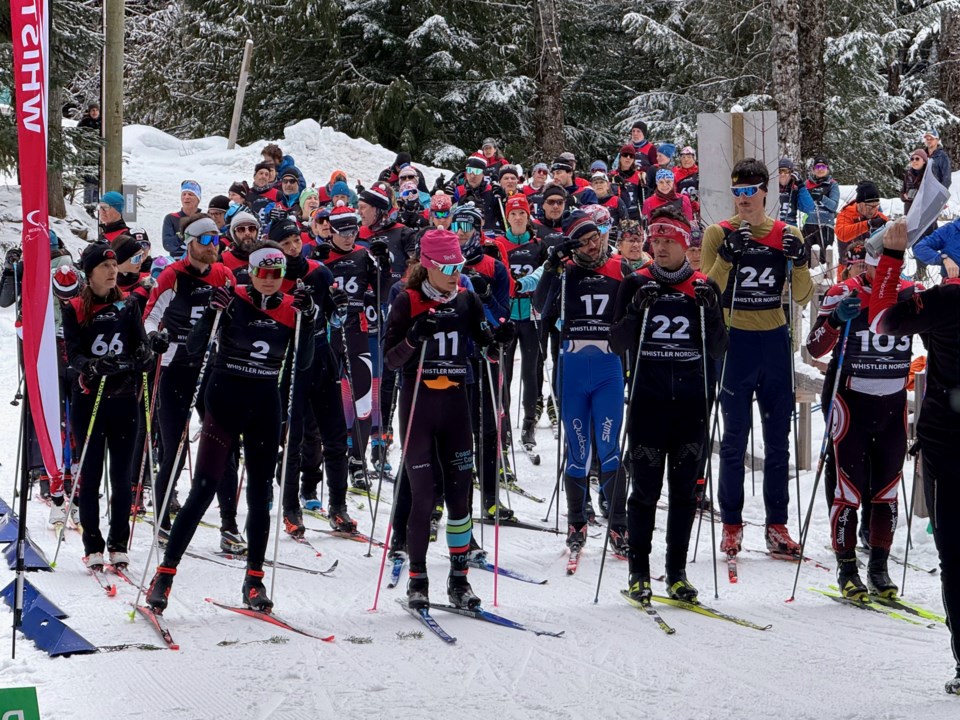Last Sunday, I participated in my first loppet in, oh, let’s call it 30-something years. But finding out about the Cheryl Morningstar Loppet at Lost Lake Park and jumping into it at the last minute reminded me how much I used to enjoy these things when, once upon a time, I was a more frequent participant.
Traditionally a large gathering of cross-country (i.e., Nordic) skiers who, over various distances, followed courses groomed specifically for classic (a.k.a. diagonal-stride) technique, skate-skiing’s current trail dominance sees most modern loppets advertised as “free technique”—meaning you can incorporate either or both. The term “loppet,” of course, originated in Europe, skiing’s motherland, where storied events like the Engadin Skimarathon, Swedish Vasaloppet, and Norwegian Birkebeinerrennet each attract upwards of 10,000.
Though I can’t say I’d be interested in inserting myself into a mob that size, we’ve got plenty of loppets across Canada each winter of which only a handful might nudge 1,000 skiers. Most are small, community/club-run events with a friendly and fun atmosphere like the Morningstar. Naturally, these are the ones both first-time and old-time loppeteers mostly patronize. In Sunday’s event in Whistler, all distances were open to any age and technique; children eight and under could tackle a three-kilometre course, while older kids plus recreational skiers (including relics like me, who may or may not be racing themselves or others), plied a nine-km loop that included a long circuit out and around Lost Lake Park and some wilder terrain on the Upper Chateau Whistler Golf Course fairways. The competitive A-types—who, to shufflers like myself seem more like well-trained, lycra-clad thoroughbreds with steam venting from their nostrils—had a two-lap 18-km course to cover. (As a measure of this last group’s ability—or my lack thereof—I was first lapped by racers on their second loop when I was about 2/3 of the way through my single go-round).
Though most know my outdoor writing through my work as an alpine ski scribe, I actually have a parallel cross-country connection. As alpine skiers starved for turns in the corn-country environs of our Southern Ontario university, friends and I indoctrinated ourselves as cross-country skiers to explore the local woods and marshlands, which eventually led us, in the early 1980s, into the nascent sport of telemarking. Which of course led us back onto the pistes. To become a certified telemark instructor under the Canadian Association of Nordic Ski Instructors (CANSI) banner, I also had to receive a Level 1 CANSI cross-country ski instructor’s badge. This latter exercise was pedagogically enlightening since none of us had the remotest idea what we were actually doing (or should have been doing) on skinny skis, and so the inculcation of actual terms and knowledge and technique changed everything, endearing me to the sport and leading me into its waxy depths. Hell, before I left Canada for my California stint as an editor at Powder magazine, I was editor of the Toronto-based North American cross-country ski magazine, SkiTrax, for years, if not participating in, then writing about many a loppet, the people who cherished them, the adrenalized energy at the start, and the volunteers marking courses and handing out food and drink, all of which I got to re-experience again.
I finished Sunday’s outing in what was probably record-slow time—pretty much the same pace I bring to the June Whistler Half Marathon and October Turkey Trot 10k running races every year. Not quite just-up-off-the-couch-and-into-it plodding, but definitely nothing really trained for in that my typical distance (and attention span) for anything is about 5k. Still, it’s nice to challenge yourself with double the regular distance and come away feeling it. And also, to come away with the enjoyment of recalling why you like it in the first place. In the case of cross-country skiing there was always so much to love about my typical solo sojourns in the woods—the snow in all its varied splendour, the dark shadows of trees across sunlit white, the tracks of myriad busy critters, the silence, and the not-so-silence of birdsong, deep breathing and millions of snow crystals crushed beneath skis that just sound like shooosh…
Having rediscovered the loppet, I would be remiss if I didn’t give plaudits to the person for which it is now named. I didn’t know Cheryl Morningstar, but was fortunate to be able to plunder whistlernordics.com to fill in the important history of one of the pioneers of Whistler’s Nordic scene. “[Cheryl] made incredible contributions to the Whistler cross-country community when it was first developing. She devoted hundreds of hours to initiating the Jackrabbit program, Track Attack, the Whistler Nordics Ski Club, and organizing the Whistler Loppet at Lost Lake. She organized coach certification courses, club programs, designed club kits, and found sponsorship money to keep it all going. Her work laid the foundation for the kids’ programs being offered in the community today… With the development of Whistler Olympic Park providing more terrain and opportunities for youth to participate, it gave Cheryl happiness to see the programs grow… She would be extremely happy to see all the kids in the various programs now, and the occasional original Whistler Nordic kit still being used.”
Indeed, she would also be happy to see the loppet whose name carries on her legacy attracting everyone from hardcore racers to recreational aspirants to energized kids to nostalgic Nordics like me.
Leslie Anthony is a Whistler-based author, editor, biologist and bon vivant who has never met a mountain he didn’t like.




